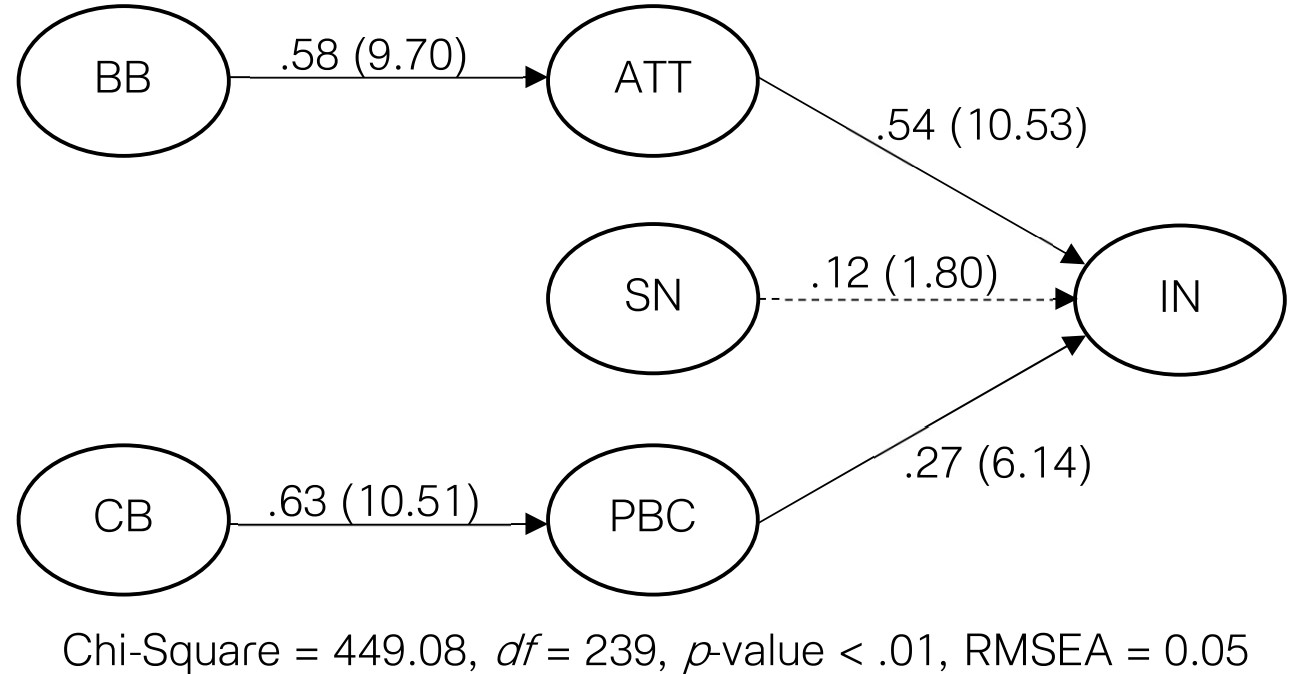การพัฒนาและตรวจสอบความตรงโมเดลเจตจำนงในการใช้และบูรณการไอซีทีในการจัดการเรียนรู้วิทยาศาสตร์
คำสำคัญ:
โมเดลสมการโครงสร้าง, การใช้และบูรณาการไอซีทีในการจัดการเรียนรู้วิทยาศาสตร์, ครูวิทยาศาสตร์บทคัดย่อ
งานวิจัยนี้มีวัตถุประสงค์เพื่อพัฒนาและทดสอบความตรงโมเดลเชิงสาเหตุเจตจำนงในการใช้และบูรณาการไอซีทีในการจัดการเรียนรู้วิทยาศาสตร์โดยใช้ทฤษฎีพฤติกรรมตามแผนของ Ajzen เป็นกรอบแนวคิด ใช้ข้อมูลจากฐานข้อมูลโครงการ Second Information Technology in Education Study (SITES 2006) ของสมาคมนานาชาติเพื่อการประเมินสัมฤทธิ์ผลทางการศึกษา ตัวอย่างวิจัยประกอบด้วยครูวิทยาศาสตร์จำนวน 679 คน จาก 456 โรงเรียน จาก 13 เขตพื้นที่การศึกษา ในการทดสอบความสอดคล้องระหว่างโมเดลกับข้อมูลเชิงประจักษ์ใช้โปรแกรม LISREL 9.1 ผลการวิจัยระบุว่า โมเดลซึ่งในข้อมูลมาตรอันดับให้ดัชนีความสอดคล้องกลมกลืนในระดับที่ยอมรับได้ (χ2 = 449.08, df = 239; χ2/df = 1.87, p < .01; RMSEA = 0.05; CFI = .99) โดยเจตคติ (β = .54, p < .01) และการรับรู้ถึงการควบคุมพฤติกรรมของตนเอง (β = .27, p < .01) มีความสัมพันธ์กับเจตจำนงอย่างมีนัยสำคัญทางสถิติ อย่างไรก็ดี บรรทัดฐานเชิงอัตวิสัยพบว่า ไม่มีความสัมพันธ์กับเจตจำนงอย่างมีนัยสำคัญทางสถิติ (β = .12, p > .05) ตัวแปรทำนายทั้งสามสามารถอธิบายความแปรปรวนของเจตจำนงได้ร้อยละ 52
References
Admiraal, W., van Vugt, F., Kranenburg, F., Köster, B., Smit, B., Weijers, S., & Lockhorst, D. (2016). Preparing pre-service teachers to integrate technology into K–12 instruction: Evaluation of a technology-infused approach. Technology, Pedagogy and Education, 26(1), 105–120. https://doi.org/10.1080/1475939x. 2016.1163283
Ajzen, I. (1985). From intentions to actions: A theory of planned behavior. In J. Kuhi & J. Beckmann (Eds.) Actionócontrol: From cognition to behavior, (11-39). Springer.
Ajzen, I., & Fishbein, M. (1980). Understanding attitudes and predicting social behavior. Prentice Hall.
Anderson, J. C., & Gerbing, D. W. (1988). Structural equation modeling in practice: A review and recommended two-step approach. Psychological Bulletin, 103(3), 411- 423.
Armitage, C. J., & Conner, M. (2001). Efficacy of the theory of planned behaviour: A meta- analytic review. British Journal of Social Psychology, 40, 471–499.
ASEAN (2011). Master plan on ASEAN connectivity: One vision, one identity, one community. Retrieved from http://www.aseansec.org/documents/MPAC.pdf.
Becker, H. J. (2001, April). How are teachers using computers in instruction? Paper presented at the Annual Meeting of the American Educational Researcher Association, Seattle.
Bahçıvan, E., Gürer, M. D., Yavuzalp, N., & Akayoğlu, S. (2019). Investigating the Relations Among Pre-Service Teachers’ Teaching/Learning Beliefs and Educational Technology Integration Competencies: a Structural Equation Modeling Study. Journal of Science Education and Technology, 28(5), 579–588. https://doi.org/10.1007/s10956-019-09788-6
Cuban, L. (1999). The technology puzzle: Why is greater access not translating into better classroom use? Education Week, 4, 68.
Demirci, A. (2009). How do teachers approach new technologies: Geography teachers’ attitudes towards Geographic Information Systems (GIS). European Journal of Educational Studies, 1(1), 43-53.
Drent, M., & Meelissen, M. (2008). Which factors obstruct or stimulate teacher educators to use ICT innovatively? Computers & Education, 51(1), 187-199.
Finnay, S. J., & DiStefano, C. (2006). Non-normal and categorical data in structural equation modeling. In G.R. Hancock & R. O. Mueller (Eds.), Structural equation modeling: A second course. Information Age Publishing.
Goldstein, G. (1997). Information technology in English schools: A commentary on inspection findings 1995-6. Coventry: NCET/OFSTED.
Hansen, T., & Jensen, J.M. (2007). Understanding consumers’ political voting decisions: A Theory of Planned Behavior Approach. Innovative Marketing, 3(4), 86-93.
Hou, M. Lin, Y. , Shen, Y., & Zhou. (2022). Explaining pre-service teachers’ intentions to use technology-enabled learning: An extended model of the Theory of Planned Behavior. Frontier in Psychology, 13, 1-13.
Kijtorntham, W., Andhivarothai, P., Kaewkor, S., & Yamtim, W. (2012). Scenarios of Thai pre-service teacher education in the next 20 years: Applying of futures wheel technique. Journal of Research Methodology, 25(3), 275-294.
Law, N., Pelgrum, W.J., & Plomp, T. (Eds.). (2008). Pedagogy and ICT use in schools around the world: Findings from the IEA SITES 2006 study. CERC- Springer.
Marcinkiewicz, H. (1996). Motivation and teachers' computer use. Paper presented at the Proceedings of selected research and development presentations at the 1996 National Convention of the Association for Educational Communications and Technology, ED 397 818.
Ministry of Information and Communication Technology (MICT). (2011). Executive summary of the Thailand ICT Policy Framework: 2011-2020 (ICT 2020). Retrieved from http://www.ict2020.in.th
Osborne, J., & Hennessy, S. (2003). Literature review in Science and the role of ICT: Promise, problems, and future directions. Futurelab Series
Peralta, H., & Costa, F.A. (2007). Teachers’ competence and confidence regarding the use of ICT. Educational Sciences Journal, 3, 75-84.
Plomp, T., Anderson, R. E., Law, N., & Quale, A. (2009). Cross-national information and communication technology: Policies and practices in education (2nd ed.). Information Age Publishing.
Preston, C., Cox, M. J., & Cox, K. (2000). Teachers as innovators: An evaluation of the motivation of teachers to use information and communications technologies. Mirandanet.
Sutton, S. (1998). Predicting and explaining intentions and behavior: How well are we doing? Journal of Applied Social Psychology, 28(15), 1317-1338.
Veen, V. (1993). The role of beliefs in the use of information technology: implications for teacher education or teaching the right thing at the right time. Journal of Information Technology for teacher education, 2(2), 139-153.
Williams, D., Coles, L., Wilson, K., Richardson, A., & Tuson, J. (2000). Teachers and ICT: current use and future needs. British Journal of Educational Technology, 31(4), 307-320.
Yang-Wallentin, F., Jöreskog, K. G., & Luo, H. (2010). Confirmatory factor analysis of ordinal variables with misspecified models. Structural Equation Modeling: A Multidisciplinary Journal, 17(3), 392-423.
Yu, C.Y. (2002). Evaluating cutoff criteria of model fit indices for latent variable models with binary and continuous outcomes (Unpublished doctoral dissertation). University of California, Los Angeles.
Yuen, A. H. K., & Ma, W. W. K. (2008). Exploring teacher acceptance of E-learning technology. Asia-Pacific Journal of Teacher Education, 36(3), 229-243.

Downloads
เผยแพร่แล้ว
How to Cite
ฉบับ
บท
License
Copyright (c) 2023 ภาควิชาวิจัยและจิตวิทยาการศึกษา คณะครุศาสตร์ จุฬาลงกรณ์มหาวิทยาลัย

This work is licensed under a Creative Commons Attribution-NonCommercial-NoDerivatives 4.0 International License.

